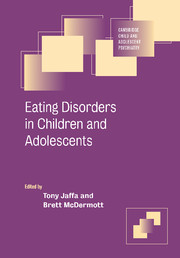Book contents
- Frontmatter
- Contents
- List of Contributors
- Part I Introduction
- Part II Scientific underpinnings
- Part III Abnormal states
- 9 Anorexia nervosa in children and adolescents
- 10 Eating disorders in boys
- 11 Bingeing and bulimia nervosa in children and adolescents
- 12 Selective eating and other atypical eating problems
- 13 Comorbid anxiety and depression and the role of trauma in children and adolescents with eating disorders
- 14 Eating disorders in children with disabilities and chronic illness
- 15 Childhood obesity
- Part IV Evidence-based care
- Part V Public health perspectives
- Index
- References
12 - Selective eating and other atypical eating problems
from Part III - Abnormal states
Published online by Cambridge University Press: 02 December 2009
- Frontmatter
- Contents
- List of Contributors
- Part I Introduction
- Part II Scientific underpinnings
- Part III Abnormal states
- 9 Anorexia nervosa in children and adolescents
- 10 Eating disorders in boys
- 11 Bingeing and bulimia nervosa in children and adolescents
- 12 Selective eating and other atypical eating problems
- 13 Comorbid anxiety and depression and the role of trauma in children and adolescents with eating disorders
- 14 Eating disorders in children with disabilities and chronic illness
- 15 Childhood obesity
- Part IV Evidence-based care
- Part V Public health perspectives
- Index
- References
Summary
Introduction
This chapter describes the range of eating problems seen in middle childhood (latency) and early adolescence (prepubertal or early puberty) that do not fit within ‘eating disorders’ as a diagnostic category. The term ‘atypical eating disorder’ is, in our view, inadequate for the range of problems described here, since ‘eating disorder’ has come to mean something highly specific, namely eating disturbances associated with weight and shape concerns and a range of specific characteristic behaviours. Indeed, eating disorder definitions are so specific that many typical cases of anorexia nervosa seen in children and young adolescents would be classified as atypical, reflecting the developmental limitation of current definitions.
Equally, the term ‘feeding disorder’ is inadequate, since feeding disorders, both in name and in formal diagnostic criteria, refer to disorders starting in infancy and early childhood (usually before age 6) and which reflect a provider/child relationship in which the ‘sufferer’ has limited if any autonomy. It is beyond the scope of this chapter to discuss feeding disorders of infancy and early childhood in full – for a summary see Chatoor (2002) and Nicholls (2004). There is limited research evidence in the area of the eating problems we will describe and most of what is known is based on clinical experience. However, it is important to emphasize that the lack of research in the area does not reflect clinical severity – all the problems outlined below can present with severe physical, social and/or psychological impairment.
Keywords
- Type
- Chapter
- Information
- Eating Disorders in Children and Adolescents , pp. 144 - 157Publisher: Cambridge University PressPrint publication year: 2006
References
- 1
- Cited by

